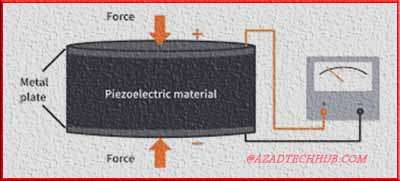Piezoelectric Effect: Important Facts You Must Know
Piezoelectric Effect
The piezoelectric effect is a fascinating phenomenon that lies at the heart of various technologies and applications in our modern world. This effect is a unique property exhibited by certain materials, both natural and synthetic, which allows them to convert mechanical stress or pressure into electrical voltage and vice versa.
In layman’s terms, it means that certain materials produce electricity when mechanical force is applied to them, and vice versa, when an electric field is applied, they deform or vibrate. Piezoelectric materials are extremely useful in a variety of industries, from sensors and transducers to medical equipment and energy harvesting, thanks to their unique property.

Read More About
Historical Background
The French physicists Jacques and Pierre Curie made the initial discovery of the piezoelectric effect in the middle of the 18th century. They discovered that under mechanical stress, some crystals—most notably quartz—exhibited electric charges. The word “piezoelectric” is derived from the Greek verb “piezein,” which means “to squeeze” or “to press,” underscoring the basic idea of using pressure to produce electricity.
How the Piezoelectric Effect Works
The crystal structure of these materials forms the basis of the piezoelectric action. They are made up of positively and negatively charged asymmetric unit cells. The separation of positive and negative charges as a result of an external force’s distortion of the crystal lattice results in an electric potential differential or voltage across the material.
The crystal lattice, on the other hand, deforms when an electric field is applied, resulting in mechanical motion or vibration.

Natural and Synthetic Piezoelectric Materials
Natural crystals like quartz, which were used extensively in early research and applications, are where the piezoelectric effect was first discovered. The creation of precise timekeeping devices, such as quartz watches, relied on the well-defined and predictable features of quartz crystals. However, researchers used synthetic materials to broaden the piezoelectric effect’s scope of use and adapt it to certain requirements.
Synthetic Piezoelectric Materials
Lead Zirconate Titanate (PZT): PZT is a commonly used synthetic piezoelectric material due to its high piezoelectric coefficients and excellent electromechanical properties. It is found in various applications, including ultrasonic transducers and actuators.
Polyvinylidene Fluoride (PVDF): PVDF is a flexible and lightweight polymer with piezoelectric properties. Its versatility makes it suitable for wearable technology, medical sensors, and energy harvesting.
Gallium Nitride (GaN): GaN is another synthetic material known for its piezoelectric properties. It is used in high-frequency and power electronics.
These synthetic materials offer engineers and designers greater control over the piezoelectric effect, allowing them to optimize materials for specific applications.
Whether it’s enhancing sensitivity in medical ultrasound probes or improving energy conversion efficiency in piezoelectric generators, synthetic materials have expanded the possibilities of this effect.
Applications of the Piezoelectric Effect
The piezoelectric effect has revolutionized multiple industries, driven innovation, and improved our quality of life:
Sensors and Transducers:
Pressure Sensors: Piezoelectric pressure sensors are used in a wide range of applications, including automotive engine management systems, industrial process monitoring, and medical devices.
Accelerometers: These sensors measure acceleration and are crucial components in devices like smartphones for screen rotation and airbag deployment in vehicles.
Touchscreens: The piezoelectric effect is used in touch-sensitive screens, providing responsive touch input in modern electronic devices.
Piezoelectric Actuators:
Inkjet Printers: Piezoelectric actuators in inkjet printers control the precise ejection of ink droplets, ensuring high-quality prints.
Autofocus Cameras: These actuators enable fast and accurate focusing in digital cameras.
Micro positioning Systems: In fields like microscopy and semiconductor manufacturing, piezoelectric actuators provide sub-nanometer precision in positioning.
Energy Harvesting:
Self-Powered Sensors: Piezoelectric energy harvesting devices capture mechanical energy from vibrations, footsteps, or other sources and convert it into electrical energy. This concept is increasingly applied in IoT sensors and remote monitoring systems.
Medical Imaging (Ultrasound):
Ultrasound Imaging: Ultrasound machines rely on piezoelectric transducers to generate and receive high-frequency sound waves for imaging internal organs and tissues, making it an essential tool in healthcare diagnostics.
Sonar Systems:
Underwater Sonar: In naval and underwater exploration, piezoelectric materials are used in sonar systems for navigation, communication, and object detection beneath the water’s surface.
Musical Instruments:
Electric Guitars: Piezoelectric pickups in electric guitars offer clear and natural sound reproduction and are popular among musicians.
Microphones: Piezoelectric microphones are used in diverse applications, including recording studios, telecommunications, and live performances.
Advances and Future Trends in Piezoelectric Technology
The piezoelectric effect continues to evolve, driven by advancements in materials science and engineering. Key trends and developments include:
Miniaturization and Nanotechnology: The miniaturization of piezoelectric components allows for their integration into smaller and more complex devices, expanding their range of applications.
Biomedical Innovations: In healthcare, researchers are exploring piezoelectric materials for applications like implantable sensors, drug delivery systems, and energy harvesting within the human body.
Green Energy Solutions: Piezoelectric energy harvesting is being harnessed in smart cities to power sensors and reduce energy consumption in buildings and infrastructure.
Integration in Internet of Things (IoT) Devices: The growth of IoT relies on energy-efficient sensors and actuators, making piezoelectric technology a valuable contributor to this ecosystem.
In conclusion, the piezoelectric effect, driven by natural and synthetic materials, has become a cornerstone of modern technology. Its applications span across diverse industries, contributing to advancements in sensors, imaging, energy harvesting, and beyond.
As research and development in materials science continue, the potential for further innovations and applications of the piezoelectric effect remains promising.
Subscribe to our Newsletter “Electrical Insights Daily” to get the latest updates in Electrical Engineering. You can also Follow us on LinkedIn and Facebook to see our latest posts on Electrical Engineering Topics.
Worth Read Posts
- Ultrasonic Motor: A Comprehensive Overview
- Servo Motors: High-Precision Control in Modern Technology
- Arduino Stepper Motor Projects: A Quick Guide
- Induction Motor: Important Types, Construction & Working
- Wound Rotor Induction Motor: Working & Important Applications
- Squirrel Cage Induction Motor: Working and Best Applications
- Brushless Motor(BLDC): Construction, Types & Applications
- Stepper Motor Position Control with Arduino: A Quick Guide

Thanks. You can Reach us at info@azadtechhub.com